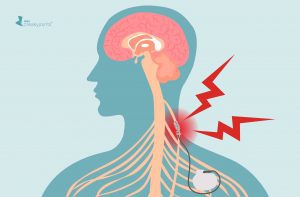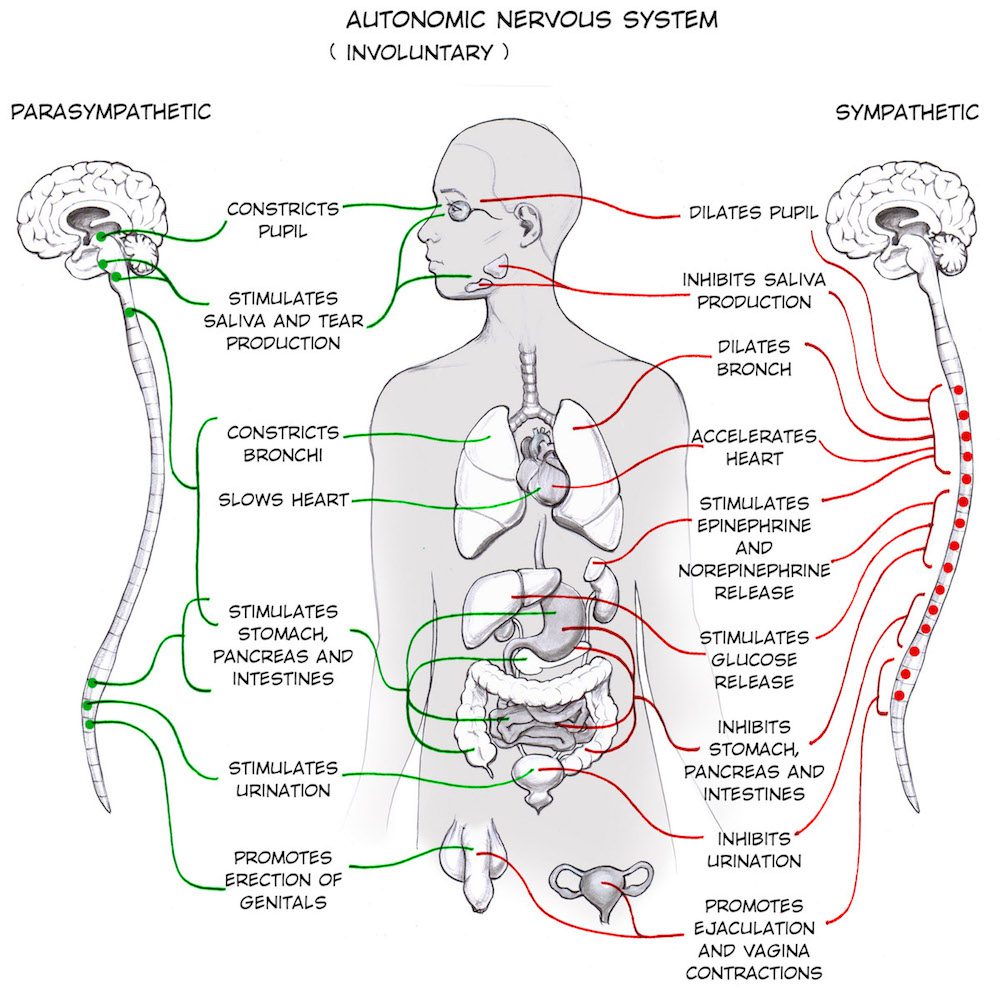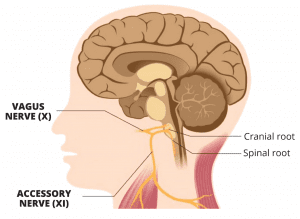The Vagus Nerve
The most important thing you can do for your health is to activate your body’s ability to heal. Stimulating your Vagus Nerve is the key to turning on your immune system and turning off stress and inflammation. Essential oils offer the easiest, most effective, non-invasive strategy to stimulate your vagus nerve and help activate your ability to stay calm and stay healthy.
The Vagus Nerve and the Parasympathetic State Your vagus nerve is your primary channel of communication between your brain and your body. Like a major highway, your vagus nerve connects your brain with your gut, heart, immune system, and all of your other major organs. It sends messages in both directions. Your vagus nerve assesses what your body needs, then directs your brain to release the appropriate chemical messengers, like hormones and neurotransmitters, that regulate and control all of the unconscious processes in your body, including your heart rate, digestion, appetite, mood, pain threshold, sleep, memory, cognitive function, and your immune response.
If your vagus nerve does not properly communicate these signals, or if the signals misfire, your body cannot stay in a state of balance. You may experience feelings of pain, fatigue, brain fog, stress, anxiety, or depression, as well as a number of neurological and even autoimmune issues.
Vagus is Latin for “wandering.” Your vagus nerve is your longest nerve, connecting your brain with almost every organ. It originates in the lower two-thirds of your brain stem, splits into two branches, and wraps around each side of your upper neck just behind your ears on the mastoid bone. It travels across the chest and down into your abdomen, connecting your brain with your larynx, pharynx, tongue, ears, lungs, gut, heart, liver, spleen, gallbladder, kidney, pancreas, intestines, and reproductive organs. It also connects with a range of other nerves that are involved in speech, eye contact, facial expressions, and ability to tune in to other people’s voices.
Your vagus nerve’s tendrils, made primarily of sensory fibers, allow it to serve as a two-way messenger, passing chemical signals between the organs and the brain to keep your body healthy. For example, this two way communication allows your brain to direct the functions of your heart, major blood vessels, airways, lungs, esophagus, stomach, and intestines, and for those organs to return important information to the brain. When your vagus nerve is working optimally, you are more likely to recover more quickly after stress, injury, or illness.
You might think of your vagus nerve as fiber-optic cables or a walkie-talkie that sends instructions between your body and your brain. This important channel for communication between the brain and body, known as the mind-body connection, plays a critical role in your ability to reduce inflammation and maintain a state of balance and health called homeostasis.
Brain: Helps control anxiety and relieve depression.
Tongue: Helps improve taste and saliva production, swallowing, and speech.
Ears: Helps to ease tinnitus.
Eyes: Helps you make eye contact.
Stomach: Helps to stimulate stomach acid for healthy digestion.
Intestines: Allows for nutrient absorption and triggers the muscle contractions to allow food and waste to
move through the digestive tract.
Pancreas: Triggers enzyme production and release for digestion.
Liver: Triggers detoxification and supports blood sugar functions.
Gallbladder: Triggers the release of bile, which rids the body of toxins and breaks down fat (critical for
most paleo and keto diets).
Heart: Helps to control heart rate and blood pressure.
Spleen: Inhibits inflammation by calming the release of pro-inflammatory cytokines(substances secreted by inflammatory cells and affect other cells).
Kidneys: Releases sodium, increases blood flow, and manages blood sugar.
Bladder: Allows for bladder retention to prevent frequent urination.
Reproductive organs and genitals: Supports fertility and sexual arousal.
Immune system: Regulates inflammation, switching off the production of proteins that fuel the inflammatory immune response.
The Autonomic Nervous System
Just like your car has a gas pedal and the brake, your nervous system has two speeds. The Sympathetic “fight or flight” state automatically helps you accelerate and avoid danger or provides a burst of energy to combat to perceived dangers. The Parasympathetic “rest, digest, and heal” state slows down the body and shifts it into a response that calms you and allows for recovery and repair after the danger has passed. The gearshift between these two states is your vagus nerve. It facilitates the constant state of balance between your sympathetic and parasympathetic systems, serving as the “on/off” switch between the two.
These two speeds states cannot exist at the same time, so when one fires, it inhibits the other. When your vagus nerve activates your parasympathetic (rest-and-digest) state, it dampens your sympathetic (fight- flight-freeze) state. The yin and yang pull of these two systems keeps your body in homeostasis or balance. Together they ensure that you have enough resources, in the right places, at the right time. For example, parasympathetic turns on your digestion, but when you sense danger, or feel anxious, your sympathetic branch kicks in and turns off digestion to free up energy for you to mobilize, fight, or flee.
All processes of your healing and health maintenance are turned on when your body is in a parasympathetic state.
Your autonomic nervous system, which manages all involuntary bodily functions that fall outside of your conscious control — heart rate, blood pressure, digestion, respiration, cell activity, and even body temperature — are built around the balance of these two opposing actions that are meant to work in rhythmic alternation.
Your sympathetic state activates the fight-or-flight response and triggers the release of stress hormones like cortisol and epinephrine (adrenaline) through your body. Your heart rate and blood pressure increase, and digestion slows or stops altogether as blood is routed away from your internal organs toward your limbs in preparation to fight or flee. Your respiratory rates increase to transport nutrients and oxygen to the cells faster. Your muscles tense and blood vessels in the extremities to constrict. This has tremendous value in survival; for example, if injured, you are less likely to bleed to death because your blood vessels constrict. Your pupils dilate so you can see more clearly.
The sympathetic state also down regulates all functions that are not critical to survival, including all healing and repair processes, like the immune system. A suppressed immune system allows viruses and bacteria to run rampant, contributing to dysbiosis, or the overgrowth of harmful bacteria in the gut , the growth of unhealthy cells such as cancer cells, or autoimmune conditions.
Your parasympathetic nervous system is associated with relaxation, regeneration, and repair. After a danger has passed, your parasympathetic nervous system brings your body back into balance by releasing the neurotransmitter acetylcholine, which helps regulate the sympathetic arousal, bringing your heart rate down, and helping you feel calm after periods of stress and anxiety.
All processes of your healing and health maintenance — including digestion, detoxification, immune activities, tissue regeneration, and being aroused — are turned on only when your body is in a parasympathetic state. The parasympathetic state is the healing state that brings your nervous system into balance. It affects EVERY aspect of your well-being! Simply put: you cannot heal outside of the parasympathetic state. You should optimally be in a parasympathetic state eighty percent of the time, but many people struggle to be in this state at any point during their day. Almost all disease and dysfunction result from you not being able to drop into the parasympathetic state.
Test Yourself: Parasympathetic State Quiz
- Dry mouth or eyes
- Clenched or grinding teeth
- Lump in throat or difficulty swallowing
- Slow bowel movements and a tendency towards constipation
- Insufficient stomach acid/GERD
- Tendency for anxiety
- Bloating or burping after fatty or fried meals
- Episodes of racing heart
- Chronic infections or compromised immune system
- Tense muscles, especially around the neck/shoulder
- Poor digestion (poor motility)
- Digestive complaints, including IBS, SIBO or Crohns
- Low Libido or Erectile Dysfunction
- ADD/ADHD
- Easily startled
- Chronic inflammation
- Frequent urination or incontinence
- Difficulty relaxing
- Sensitive to bright or flashing lights
- Difficulty sleeping or nightmares
- Floating stool
- Migraines, dizziness or vertigo
- High or low blood pressure
- Chronic tension
- Tendency for depression
- Digestive disorders including leaky gut and food allergies
- Not being able to tell when you are full or hungry
- Sleep problems
Does this sound like you? Then you may need help shifting into the parasympathetic state.
- Improves digestion
- Speeds Detoxification
- Combats Inflammation
- Boosts Immunity
- Reduces Symptoms of Depression
- Decreases Anxiety
- Relieves Pain
- Improves Gut Health
- Calms Stress
- Increases Adrenal Health
- Boosts Energy
- Improves Heart Health
- Increases Muscle Strength
- Enhances Sexual Health
- Balances Blood Sugar
- Releases Trauma and Post Traumatic Stress Disorder (PTSD)
- Relieves Insomnia
- Regulates Appetite and Weight
- Strengthens Memory
- Enhances Breathing
Vagus Nerve Stimulation
Many have heard the “use it or you lose it” policy when it comes to accrued vacation time. Your vagus nerve works in a similar fashion. If you don’t use it and develop what is known as vagal tone, or the resilience to toggle between the parasympathetic and sympathetic nervous system actions, it doesn’t work as well. It could even atrophy. You might think of it like muscle tone. If you don’t use your muscle, it atrophies. Stress, toxins, and trauma keep your vagal switch stuck in the off mode. A key strategy for toning your vagus nerve is to stimulate it. Stimulation activates communication between your body and your brain that triggers the release of different chemical messengers, like neurotransmitters, that improve communication between all the organ systems connected to your vagus nerve.
Essential oils are natural, noninvasive, easy tools to use to activate your vagus nerve. They possess both olfactory (smell) and transdermal (topical application) qualities, making them easy to inhale and apply on the skin to activate your vagus nerve.
Research backs this up as inhaling essential oils such as lavender or bergamot has been shown to activate your vagus nerve as measured by improved heart rate variability. Inhaled essential oils travel directly to your brain (specifically to the prefrontal cortex behind your forehead) where they can immediately help calm the fear response in your brain. In addition, topically applied essential oils can cross the blood-brain barrier to stimulate your vagus nerve within the brain.
Applying essential oils on specific healing points known as acupuncture points or reflexology points that are correlated with specific organ systems or regions of the brain, like the vagus nerve. Acupuncture points behind the ear and around the neck are the most effective points for stimulating the vagus nerve. A neural anatomy study showed the vagus nerve is most accessible for stimulation via the lower half of the back ear.
Research on “acupuncture and vagus nerve stimulation(VNS) found that acupuncture points produce clinical benefits through stimulation of the vagus nerve and/or its branches in the head and neck region that are anatomically proximate to vagus nerve pathways there, where the VNS electrode is surgically implanted.” Research has shown a strong decrease in inflammatory symptoms from stimulation of three minutes a day, indicating that less might be more.
Vagus Stimulators:
Modius Health – https://us.modiushealth.com/pages/science
Vagus.net – https://vagus.net/shop/stimulator/
You can do an epigenetic reset your nervous system.
Inhalation through your nose followed by a long exhale from your mouth is a form of diaphragmatic breathing that stimulates your vagus nerve, since the vagus nerve passes through your diaphragm. Exhaling longer than you inhale also helps to activate your vagus nerve.
Neuroplasticity
Neuroplasticity is the brain’s ability to form new neural Pathways and synaptic Connections in response to learning, having new experiences or healing from an injury. In layman’s terms, neuroplasticity is the brain’s ability to bounce back, and grow. If something is thrown in the brain’s path, it can learn how to work around it.
Imagine your neural connections are like a roadmap. Let’s say you usually take the highway into work, but one day, there’s suddenly a major crash, and all lanes are closed. Do you stop going into work? even if you wish you could head back home, the answer is probably no.
You don’t give up, instead, you find an alternate route. You may have to take some smaller back roads (maybe even a few off the beaten path) and it will probably take you a little longer, but in the end you still reach your destination. This is what neuroplasticity is all about. If the brain encounters a roadblock, it will find another way to make that connection.
The opposite is true when we learn, it’s like you’re suddenly a local in a small town. You know all the shortcuts, you know which roads to avoid on Tuesday afternoons, and you know all the protips tourists are dying to know. You know the better, faster route to take, and these new roads gradually become your new normal pathway.
When you start building a new habit, it’s like you’re building a new Road in the brain. You start by laying down one stone at a time. It’s a slow process and that new pathway might not seem very strong or safe at first.
You’re probably looking over how much easier it would be to take that route! But the more you work on your new road, the clearer that path will become. Pretty soon, it’ll become the shortcut, your go-to choice. Heading that new pathway can do more for your body than just make your weight loss Journey easier. In fact, Paving new Pathways helps to keep your brain Young.
Our brains love learning. Every time you learn, you forge a new neural pathway in the brain. The longer you learn, and the more you learn, the more new Pathways you create. Along the way, you’ll build a whole new expressway, transit system, and map that is your cognitive city, as your new habits become your new norm.
Aerobic activity, curio, increases neuroplasticity. When we move our bodies, we produce brain derived neurotrophic Factor. BDNF is a growth hormone that allows us to create new neurons, and helps our neurons to grow, reshape, and form synapses.
Activities like sprints and high intensity interval training can increase your body’s BDNF production.
In one study, volunteers were divided into three groups, resters, light joggers, and sprinters. Then they measured their BDNF and learning after their activity. The study found that sprinters had the greatest increase of BDNF and were able to learn new vocabulary 20% faster.





